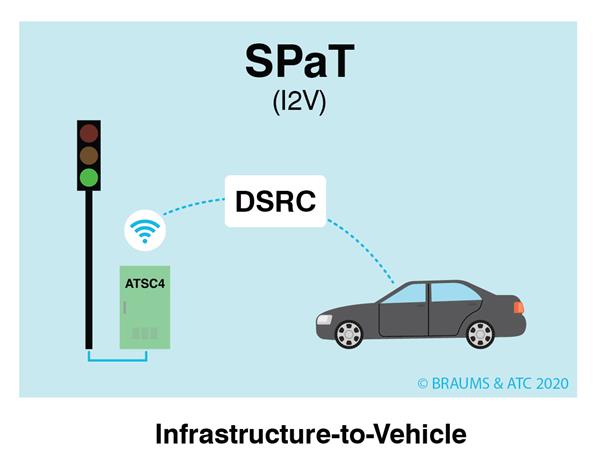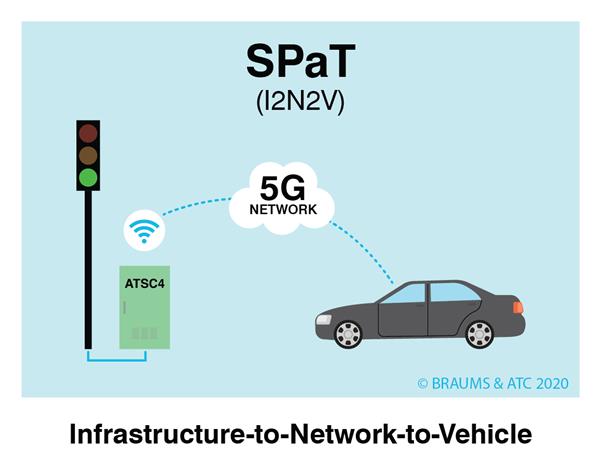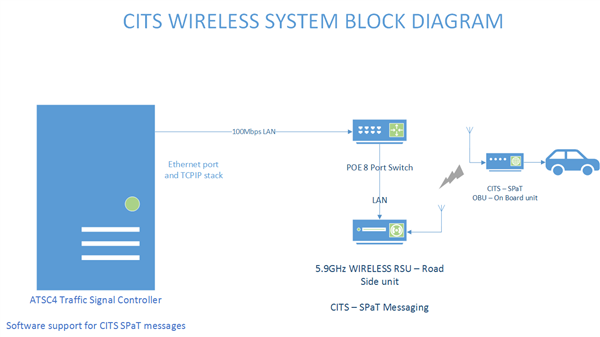In the ITS world, both vehicles and infrastructure are becoming more intelligent as they will soon be talking and exchanging data relevant to each other.
What is SPaT?
SPaT, or Signal Phasing and Timing, describes a series of messages that are part of what is commonly known as Cooperative Intelligent Transport Systems or CITS (pronounced a Cee-ITS) which are a series of international standards available to all road authorities and vehicle manufacturers.
In the context of the ATSC4 Traffic Signal Controller, the ATSC4 represents the infrastructure component. The ATSC4 will be responsible for transmitting data to the vehicles telling them which signals are green, yellow or red and in a set of limited cases, the time left to cross an intersection for a specific approach (road into the intersection).
How does SPaT work?
Currently, the infrastructure component transmits its data directly to the vehicle using one of two internationally sanctioned radio bands; DSRC (Dedicated Short Range Communications) and V2X (Vehicle to Everything). Both technologies use portions of the 5.9GHz frequency band which have been allocated worldwide for this purpose.
DSRC is a standard that allows a vehicle to communicate with road side devices as well as other vehicles. V2X is a cellular communications band that uses a dedicated mobile phone frequency for CITS.

Moving forward, SPaT in Australia will utilise 5G (fifth generation) wireless technology network, with infrastructure components broadcasting information to vehicles via the cloud. The ATSC4 can be adapted to transmit data at different frequencies over the 5G network.

The vehicles can use data about the current state of an intersection – whether it is operational or not, but more importantly, the Traffic Signal Controller at an intersection will advertise both signal (colour of traffic lights) and timing data, as well as map data – or the layout of the intersection so a vehicle knows which lane to use to cross an intersection.
How does SPaT data help vehicles on the road?
SPaT and map data have been defined in a standard known as SAE J2735 and both messages are transmitted every 100mS (1/10th of a second) to all vehicles and identified as being sent from a specific intersection.

The SPaT data sent from a SCATS driven traffic signal controller to a vehicle will indicate if the green signal is displayed and timing or whether yellow or red and the specific time left. For SCATS systems which are fully adaptive, the green signal time is generally not known in advance because it varies from cycle to cycle. So for adaptive systems such as SCATS, a value representing infinity is provided to vehicles which is interpreted as allowed to proceed through an intersection. For Yellow and Red Traffic Signals, these typically have defined duration times and thus, the SPaT message will contain the time left in seconds with 1/10th of a second accuracy.
The SPaT data can be used by a vehicle to warn the driver of a change of signal colour and in future, such data can be used by driver assisted devices to "stop" a vehicle automatically if the driver does not perform any action to brake and stop as indicated by the signals.